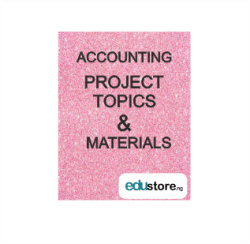THE IMPACT COSTING TECHNIQUES ON A PROFITABILITY OF A MANUFACTURING COMPANY (A CASE STUDY OF DANGOTE FLOUR MILLS PLC, CALABAR)
ABSTRACT
This project emphasize on costing in an organization. It is phenomenon for every organization (manufacturing). It is mandatory for every organization (manufacturing company) to adopt any costing techniques in an organization that is deemed appropriate but it can be combined with any of the costing technique. Thus, the desire to find out the impact of costing technique to manufacturing company ignited this study. This work examined the impact of costing technique of an organization which is particular to Dangote Flour Mills PLC, Calabar. To achieve this purpose, five research questions were formulated to guide this study. A structured questionnaire was used as the main instrument for data collection from 90 personnel and staff of the company and sample size of 74. The data collection from the respondent was analyzed using simple percentage. The result revealed with the achievement of and the most technique that is deemed appropriate in Dangote Flour Mills PLC, Calabar.
TABLE OF CONTENT
Title Page
Cover Page
Certification – – – – – – – – i
Dedication – – – – – – – – – ii
Acknowledgement – – – – – – – iii
Abstract – – – – – – – – – iv
Table of content – – – – – – – – v
CHAPTER ONE – INTRODUCTION
1.1 The Background of the Study – – – – 1
1.2 The Statement of the Study – – – – – 3
1.3 Objectives of the Study – – – – – – 3
1.4 Research Questions – – – – – – 4
1.5 Significance of the Study – – – – – 5
1.6 Scope of the Study – – – – – – 5
1.7 Limitations of the Study – – – – – 6
1.8 Definition of Terms and Acronyms – – – – 6
1.9 Organization of the Study – – – – – 8
CHAPTER TWO: REVIEW OF RELATED LITERATURE
2.1 Introduction – – – – – – 9
2.2 Definition of Costing – – – – – 11
2.3 Types of Costing – – – – – – 11
2.3.1 Prevailing Factor associated with Costing – – 17
2.4 Pitfall involved in Costing – – – – 19
2.5 Management Accounting Techniques – – 23
2.6 Standard Costing Technique – – – – 23
2.7 Types of Standard Costing Technique – – 25
2.8 Theoretical Framework – – – – – 29
2.9 Current Development on Costing Technique – 30
2.10 Costing Procedures of Charging Overhead to
Manufacturing Output – – – – – – 32
2.11 The Distinction between Job Costing, Batch Costing
and Process Costing – – – – – – 33
2.12 Summary of Review of related Literature – – 34
CHAPTER THREE
3.0 Introduction – – – – – – 36
3.1 Area of the Study – – – – – 36
3.2 Population of the Study – – – – 36
3.3 Sampling Technique/Sampling Size Determination 37
3.4 Sources of Data Collection – – – – 38
3.5 Method of Data Collection – – – – 38
3.6 Method of Data Analysis – – – – 39
CHAPTER FOUR
PRESENTATION, ANALYSIS AND INTERPRETATION OF DATA
4.1 Introduction – – – – – – 40
4.2 Presentation and Analysis of Data – – – 40
4.3 Data Analysis and Interpretation – – – 41
4.4 Discussion of findings – – – – – 47
CHAPTER FIVE
SUMMARY, RECOMMENDATION AND CONCLUSION
5.1 Introduction – – – – – – 49
5.2 Summary – – – – – – – 49
5.3 Conclusion – – – – – – – 51
5.4 Recommendation s – – – – – 52
REFERENCES
APPENDIX
DOWNLOAD COMPLETE WORK- For Reference Only: Materials are for research, citation, and idea generation purposes and not for submission as your original final year project work.
- Avoid Plagiarism: Do not copy or submit this content as your own project. Doing so may result in academic consequences.
- Use as a Framework: This complete project research material should guide the development of your own final year project work.
- Academic Access: This platform is designed to reduce the stress of visiting school libraries by providing easy access to research materials.
- Institutional Support: Tertiary institutions encourage the review of previous academic works such as journals and theses.
- Open Education: The site is maintained through paid subscriptions to continue offering open access educational resources.






